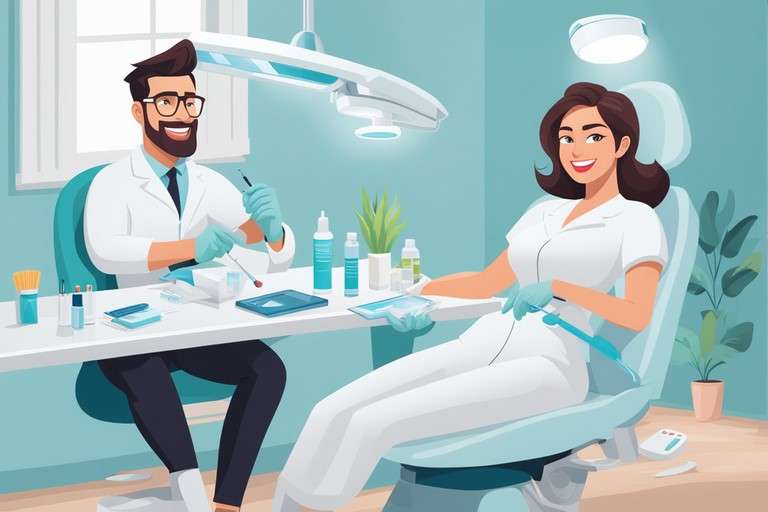The professional teeth whitening process can result in gleaming white teeth which not only make a great first impression but also boost self-confidence. However, in the field of dentistry, it’s understood that over-whitening using a whitening product carries risks such as sensitive gums and rapid re-staining due to tooth staining. This guide offers best practices on safe at-home whitening frequency to balance efficacy with health.
Key Takeaways
- Professional whitening should be limited to once every 6 months
- Use custom trays and gel for 1-2 weeks between dentist visits
- Whitening strips work for touch-ups every 1-3 days
- Consult experts to customize the ideal routine for your needs
With the growing popularity of whitening treatments, many wonder how often should you whiten your teeth without causing harm. We cover the safe frequency guidelines.
Types of Teeth Whitening Treatments
Professional In-Office Whitening uses the highest concentrations of bleaching gel alongside special lights or lasers to swiftly lift deep stains in one visit. In dentistry, custom-fit trays are often provided for follow-up treatments to whiten teeth without causing damage.
Whitening Trays are custom-made plastic molds designed to hold whitening gel against teeth evenly for longer stain fighting contact. These trays allow a mess-free application of the whitening product.
Whitening Strips offer a budget lift for mild stains with thin, disposable strips coated in hydrogen peroxide to wear for 30 minutes or less daily. No trays are required when using these whitening strips to whiten my teeth.
Whitening Toothpastes and Natural Remedies like baking soda, lemon juice, or charcoal provide a very gentle brightening over longer periods. Results are modest compared to stronger chemical solutions.
Top Recommended Whitening Brands: SportingSmile, Byte
Evaluating the Safety of Teeth Whitening
The ADA asserts that hydrogen and carbamide peroxide whitening agents are generally safe for enamel and gums when following manufacturer instructions carefully. However, misuse or overuse can trigger gum inflammation and tooth sensitivity. Limit potency to 10% hydrogen peroxide or lower concentrations per application.
Watch for throat irritation as well during at-home sessions from accidental swallowing of gel. Fortunately, side effects are temporary and reverse after treatment ends. Still, caution is warranted.
Common Side Effects of Teeth Whitening
Tooth sensitivity is the most frequent side effect, arising in over 50% of patients with varying degrees of intensity depending on genetics and prior condition of one’s enamel. Gum irritation may also occur, usually resolving within 1-2 days.
As whitening agents strip off layers of stains, they simultaneously dehydrate the enamel. This porosity enables darker stains to rapidly reaccumulate after treatment stops, especially with smoking, red wine, soda and coffee consumption.
Recommended Whitening Frequency

Wikipedia advises these home treatment guidelines:
- In-office bleaching no more than every 6 months for highest peroxide concentrations
- Custom take-home trays loaded with gel for 10-20 minutes 1-2 times per week
- Adhesive whitening strips for 1-3 consecutive days then discontinuing
- Maintenance as needed with additional cycles
With professional oversight, you can safely achieve noticeably brighter teeth a few shades lighter. However, attempting to go too white too fast raises the risks of permanent gum damage or a “bleached” overly gray appearance from enamel erosion. This is where balancing safety and efficacy comes in with smart frequency caps.

Professional Teeth Whitening Treatments vs. At-Home Treatments

In-office procedures performed under a dentist’s supervision can provide the most dramatic results the fastest, with stains lifted by 8 or more shades in one 60- to 90-minute appointment. However, the higher peroxide strength carries higher risks described above if misused.
Over-the-counter methods require greater patience for more gradual brightening, lightening stains by roughly 2-3 shades per cycle. But done properly, research shows custom trays enable users to match and possibly exceed professional outcomes over 2-4 weeks of daily use.
With dentist guidance on molding quality custom trays properly to your teeth, you receive the whitening gel concentration ideal for your needs. Kits allow touching up whenever stains return without paying clinic fees.
Custom trays are critical for holding whitening gel snugly against pearly whites for maximum contact rather than just brushing it across uneven surface areas quickly. Ill-fitted strips often fail to reach molars and rear teeth with the same effectiveness.
Factors That Impact Whitening Duration
These considerations all dictate required “contact time” – how long bleach must remain active on teeth to lift your degree of discoloration.
- Natural porosity and translucency of your tooth enamel
- Intensity of staining present – intrinsic vs surface-level
- Number of teeth being whitened in treatment plan
- Concentration levels of whitening gel used
Stains from food and drinks, antibiotic side effects, injuries, genetics and age all permeate the porous enamel differently. As we get older, enamel thins and yellows naturally too from gradual mineral loss. These factors make whitening efficacy and duration highly individual.
Seeking Dentist Guidance on Ideal Regimen

Consulting an experienced dentist allows customizing your whitening regimen to your smile’s needs based on:
- Examining type of stains present
- Assessing rate of staining
- Detecting potential causes like micro-fractures
- Monitoring for sensitivity or gum irritation
- Advising on ideal peroxide strength needed
With the right information and whitening strategy tailored to your unique whiten teeth, you brighten stains safely, minimizing risks and duration to your desired shade. Follow any special precautions on gel usage recommended.
Limits For How Often Should You Whiten
Aesthetic dentists generally recommend once yearly touch-ups as optimal for maintenance after the initial whitening intensive. While not firmly proven, some caution applying gel too much could potentially degrade enamel over years or even decades.
Why? Frequent cyclical dehydration from peroxide may subtly erode protective mineral layers guarding pores. This could enable future stains permeating deeper internally.
However, sensitivity and gum health remain the larger pressing risks demanding moderation. So remembering less is more helps maintain that vibrant, healthier glow long-term.
Keeping Your New Smile Long and Bright
Consistently practicing good oral hygiene and limiting teeth-staining foods helps prolong a glowing smile between occasional touch-ups:
- Brush gently 2-3 times daily -Regular flossing
- Rinsing after coffee, wine or tobacco
- Avoiding excess citrus, berries red sauces or juices
With reasonable precautions, you can dazzle everyone with your dramatically brighter grin more days of the year. Just be wise by not overdoing treatments.
For the custom regimen right for your lifestyle and dental needs, consult our whitening specialists today. And remember to sign up below for helpful oral care tips sent straight to your inbox!
